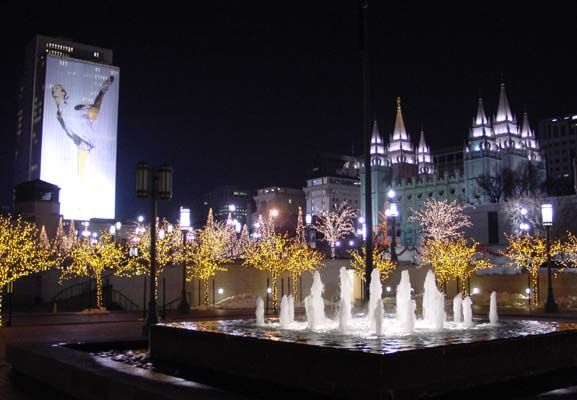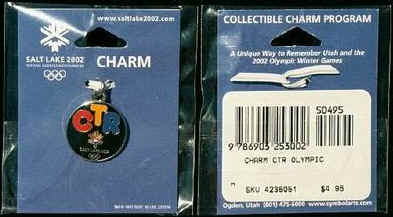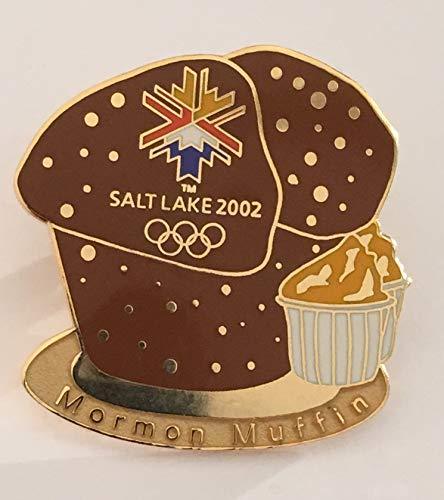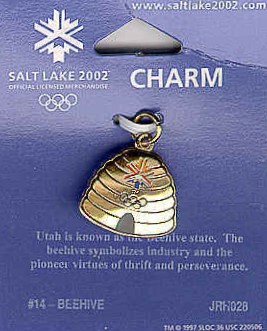~~ |
How the Mormon
Church Planned to Capitalize
|
~~ |

Every four years, figure skaters glide and ski jumpers soar against a backdrop of snow and ice—and amidst a marketing blizzard of products carrying the five rings of the Olympic logo. But the 2002 Salt Lake City Winter Games could mark the first time the event has been used as a marketing tool by an organized religion.
As Salt Lake City gears up for next year's Winter Olympics, the Mormon leadership is taking another step to appear more "Christian."
|
Six years ago they redesigned the church logo to emphasize the name of Jesus Christ. Now a new directive has gone out from Mormon President Gordon B. Hinckley to the "faithful." |
|
"As the Church grows across
boundaries, cultures and languages, the use of the revealed name, The Church of
Jesus Christ of Latter-day Saints, is increasingly important in our
responsibility to proclaim the name of the Savior throughout all the
world," says the letter to be posted in all local Mormon churches. (Is
this because in certain dialects of Chinese the word Mor-mon means "the
gates of hell?")
But who is this "Savior?" Is
it the same One described in the Bible? The average Mormon layman would be
surprised at the question and would probably answer, "Of course. There is
only one "Jesus."
But, a careful study of the Book of
Mormon and other central Mormon literature reveals a very different person than
the biblical Savior.
Three major differences emerge. Instead
of the eternal Jesus co-equal with the Father, the Mormon Jesus was once a man
who achieved godhood by his own virtuousness during a pre-incarnate existence.
His spirit was then impregnated into the virgin Mary by the "Eternal
Father" who came from the planet Kolob for the physical union with her.
Second, Mormonism teaches that Jesus
and Lucifer are brothers who competed for the opportunity to become the savior
of planet earth. Jesus' plan won approval and Lucifer rebelled and became the
tempter and deceiver of planet earth.
Third, Jesus is only one of many
saviors who are each responsible for the salvation of the population of other
planets like earth. Mormon men are working with the promise that they, too, will
eventually become gods and be given a planet of their own to populate. This will
be accomplished by their intercourse with many wives who will bear millions of
spirit children to inhabit the bodies of the people on their planet.
Mormons are actively recruiting through
TV and other media. They are presenting themselves as a church of Jesus Christ
which most people assume is "Christian."
|
THE SPIRES of the Mormon Temple will serve as the centerpiece for the 17-day-long Olympic Games. Temple Square-headquarters for the Church of Jesus Christ of Latter-day Saints (LDS)—will be, like the downhill ski run, an Olympic venue. Every medal ceremony will take place against the backdrop of the temple’s spires. And the number of informative but surprisingly mellow missionaries who stroll the square will be beefed up to greet the more than 200,000 Olympic visitors expected to tour the church’s sprawling downtown campus. |
“These will be the
Mo-lympics,” says Steve Pace, a Salt Lake health-care consultant, Olympics
critic and lapsed member of the church. “Almost everything that happens in
Utah usually has a church spin on it. And the church has never been able to do
anything with a small bit of a light touch.”
The Mormons say the Games are not a proselytizing opportunity
but a public-relations mission. Church officials scoff at Pace and others who
presume that street-corner conversions, demands for temperance and a defense of
the long-rejected practice of polygamy will dominate the Games, a $1.3 billion
production staged by the Salt Lake Organizing Committee (SLOC). Instead, says
Michael Otterson, the church’s chief spokesman and a member of its Olympics
coordinating committee, the LDS’s fundamental goals are to use the Olympics to
show that the people of Utah—70 percent of whom are church members—can be
“good hosts and to correct misperceptions.” Otterson adds: “The Games have
been awarded to Salt Lake City, not to the church.”
Sometimes, separating the two is difficult. Founded on the
belief that God, Jesus and an angel came to founder Joseph Smith Jr. 180 years
ago in a grove of trees in upstate New York, the Mormon Church is booming, with
11 million members worldwide, half in the United States. In addition, the church
is wealthy—with holdings worth some $30 billion—and experienced at savvy,
pinpoint marketing.
Months ago, the Mormons beat the multitude of official Olympic sponsors—known
for sending message-filled trinkets to the media—to the publicity punch. Last
fall, hundreds of journalists received tiny, finely detailed, attaché cases.
Inside the four-inch-wide briefcases were panels of LDS-related story ideas.
Later, a lush calendar of Mormon events was sent. During the Olympics, the
church will host its own posh media center. And it’ll stage lavish shows in
its new 21,000-seat Conference Center, a building seven times the size of New
York’s Metropolitan Opera House. Church officials are hush-hush about the
details of the expected “Olympic offerings” at the conference center. But
high-tech theater and music will surely be part of the religiously themed
extravaganzas that are expected to be open to the public.
|
Months ago, the Mormons beat the multitude of official Olympic sponsors—known
for sending message-filled trinkets to the media—to the publicity punch. Last
fall, hundreds of journalists received tiny, finely detailed, attaché cases.
Inside the four-inch-wide briefcases were panels of LDS-related story ideas.
Later, a lush calendar of Mormon events was sent. During the Olympics, the
church will host its own posh media center. And it’ll stage lavish shows in
its new 21,000-seat Conference Center, a building seven times the size of New
York’s Metropolitan Opera House. Church officials are hush-hush about the
details of the expected “Olympic offerings” at the conference center. But
high-tech theater and music will surely be part of the religiously themed
extravaganzas that are expected to be open to the public.
When Salt Lake first bid for the Winter Olympics,
church-linked businesses chipped in $211,000. Weeks before allegations emerged
that SLOC officials had bribed members of the International Olympic
Committee—a federal trial of two former SLOC members is scheduled for this
summer—LDS president Gordon B. Hinckley publicly urged his flock to volunteer
for SLOC. |
|
 LDS
Slogan
LDS
Slogan
Leading a Charmed Life
BY
LINDA FANTIN
THE SALT LAKE TRIBUNE
The purple package containing Deseret Book's Olympic CTR
charm calls it a "unique" way to remember Utah and the 2002 Olympic
Winter Games.
That's an understatement.
CTR is an LDS Church-copyrighted acronym for "Choose the
Right" and the Salt Lake Organizing Committee has a policy prohibiting
official licensees from using religious symbols on 2002 merchandise.
Still, the committee won't demand the products be pulled from
the shelf, spokeswoman Caroline Shaw said Friday.
"The [SLOC] licensing manager who approved it made a
mistake," said Shaw, noting the person was not from Utah and did not
understand the LDS connotation. "Given the fact that we approved the
initial artwork, we're not going to be heavy handed toward the licensee."
SLOC did instruct Ogden-based SymbolArts to cease production
and distribution of the $4.95 charms, but the bookstore chain owned by The
Church of Jesus Christ of Latter-day Saints ordered only 5,000 and they were
delivered three weeks ago.
Shaw draws a line between approving the design of a product
and endorsing its message.
"It's not our official charm," she said.
But the package states that it is, indeed,
"official."
An official Olympic charm depicting an official LDS symbol
will do little to lessen the perception that the 2002 Winter Olympics are the
"Mormon Games," a moniker SLOC President Mitt Romney and LDS Church
officials have gone to great lengths to debunk, calling the depiction
destructive and divisive.
Shaw said she doesn't believe the sale of the CTR charm
undermines SLOC's position.
Nonetheless, news of the charm raised eyebrows at the U.S.
Olympic Committee, which promptly called SLOC and requested an explanation. USOC
spokesman Mike Moran would not comment on the record and said only that the USOC
had nothing to do with the licensing deal.
SymbolArts has a separate contract to produce 500,000 CTR
rings for the LDS Church, said salesmen Mike Leatham. He said the Olympic
collectible was not an attempt to use the Olympics to promote the LDS Church. He
likened it to several other charms and pins that depict icons associated with
Utah culture like green Jell-O and "Mormon Muffins."
"[The CTR charm] is just somebody's idea to help support
the Olympics," Leatham said. SLOC, which earns about a 15 percent royalty
on licensee merchandise, stands to make about $3,700 if all the charms are sold.
Leatham also argued that CTR can stand for a lot of things,
including "Catholics Totally Rule" and "Corrupt the
Righteous." But he acknowledged that, in this case, it stands for
"Choose the Right."
And you can find it at Deseret Book at the counter where all
the other CTR rings, charms and merchandise are sold -- while supplies last.
Don't miss these other charms that have been produced, all depicting LDS symbols, showing how the Mormon church has used this opportunity of PR to proselytize during the 2002 Winter Olympics


The Beehive is a symbol used by the Mormon religion. Here we have one of the new charms compared to one of the many doorknobs of the Salt Lake Temple. This is was used as a religious symbol before Utah gained statehood.

.jpg)
Do you notice that this charm only mentions Brigham Young as a prophet? They could have attempted to try and pull this one over if they would have mentioned that he was the first governor of Utah instead.
.jpg) The
Salamander letter stands out as a real masterpiece among the forgeries Mark
Hofmann sold to the LDS Church. What ever happened to the ability of the Prophet
as a "Prophet, Seer, and Revelator, one will never know. While it has
defects as far as the text is concerned, the handwriting is beautifully executed
and the physical appearance is so good that it could fool the best of experts.
Even examination under ultraviolet light does not seem to reveal the flaws found
in many of Hofmann's other documents.
The
Salamander letter stands out as a real masterpiece among the forgeries Mark
Hofmann sold to the LDS Church. What ever happened to the ability of the Prophet
as a "Prophet, Seer, and Revelator, one will never know. While it has
defects as far as the text is concerned, the handwriting is beautifully executed
and the physical appearance is so good that it could fool the best of experts.
Even examination under ultraviolet light does not seem to reveal the flaws found
in many of Hofmann's other documents.
Mr. Hofmann must have known that the letter would receive a
great deal of scrutiny because of its controversial contents and that it would
probably end up in the hands of document examiners. Allen Roberts and Fred
Esplin wrote the following with regard to the Salamander letter:
"Jacobs and Hofmann said they realized they possessed something which would make the controversy over the Joseph Smith III blessing pale by comparison....
"The implications of the letter were not lost on Hofmann and Jacobs. If Harris's description was taken literally, it challenged Joseph Smith's later official testimony that he had received the plates from an angel. The letter was a potential source of conflict and controversy in Mormon history." (Utah Holiday, Jan. 1986, p. 54)
The Deseret News for May 12, 1986, reported:
"A Utah documents expert has given additional testimony that the controversial Martin Harris letter—better known as the 'White Salamander Letter'—is a forgery....
Olympics 2002, Mormon-style
Winter Games will offer a close-up view. The church
welcomes it.
By Larry Fish
INQUIRER STAFF WRITER
SALT LAKE CITY - When gold medals are handed out at
the 2002 Winter Games, the ceremony will take place on a plaza built and owned
by the Church of Jesus Christ of Latter-day Saints.
TV cameras - and thus the eyes of the world - will have
little choice but to linger on the church's nearby gothic Temple, bristling with
spires, and on other buildings that make up the headquarters of a rapidly
growing American-born faith that claims 11 million members worldwide.
Though tainted by a bidding scandal, Salt Lake City's Winter
Games will certainly focus much of the world's attention on a dynamic Mormon
culture, which is why the media-savvy church is gearing up to capitalize on the
opportunity.
Church officials say they will go for the soft sell - no
aggressive missionaries or overt ties between the Games and the church. But the
location of the medals plaza alone guarantees that billions of people worldwide
will be exposed to the church's teachings.
"I think it is fair to say that there will be a positive
impact," said Elder W. Craig Zwick, president of the missionary district
that includes Pennsylvania and New Jersey. "It's a name-recognition
deal."
Elder Zwick, like many others, hopes that camera shots of the
Temple will become the Games' signature image, and that the media, in telling
the church's story, won't get "hung up on polygamy, Mormon wealth, and a
lot of things that don't matter."
For Salt Lake City's mayor, Rocky Anderson, the challenge
will be to get people to look beyond the church to see his city.
Anderson was so chagrined when Mitt Romney - a Mormon and the
head of the Salt Lake Organizing Committee - agreed to siting the medals plaza
in the Temple's backyard that he won a promise that the five illuminated Olympic
rings would be hung only on the century-old City Hall building, the symbol of
secular Salt Lake.
Putting the rings on City Hall, Anderson said, is an
important part of "the look of the Games in Salt Lake City, how we will
present ourselves."
"We wanted to dispute any notion that there is going to
be any one icon or image presented to the world," Anderson said.
Raised in the church but no longer a member, the former trial
lawyer was elected in 1999 to lead a city where the non-Mormon population has
grown to 52 percent, in a state still 70 percent Mormon.
He, like everyone else, knows the spotlight will be shining
on the church, which plans its own media operation barely a block from the
Olympics' official center, to handle requests from the 11,500 media
representatives expected.
For Michael R. Otterson, the church's director of media
relations, the important thing will be for the church and community "to be
a good host."
He and others closely watched the Summer Games in Sydney,
Australia, and noted the favorable reputation that city garnered.
"It's the lasting impression that people have 10 or 15
years away," Otterson said, that is the chief benefit of hosting the Games.
Church officials also know that media accounts of the history
of Salt Lake City, and of Utah, cannot avoid the subject of the church, because,
to an extent, they are one and the same.
Led by the prophet Brigham Young, the Mormons arrived at the
Great Salt Lake in 1847, fleeing the persecution that dogged their unique form
of Christianity.
It was begun by Joseph Smith in 1830, when, by Smith's
account, an angel named Moroni led him to a hillside in Upstate New York, where
he uncovered golden tablets that the angel translated as the Book of Mormon.
The Book of Mormon details Christ's ministry in North
America, where it says he appeared after his resurrection to the remnants of the
10 Lost Tribes of Israel. With Christ's eventual departure, true Christianity
was absent for 1,800 years, until Moroni restored it.
This Mormon version of Christianity, which originally
sanctioned polygamy, invited the wrath of non-Mormons, and Smith was killed by
an irate mob in Illinois. The danger led Young to bring his followers to the
remote Salt Lake valley to establish their Zion in freedom. Here, they have
flourished ever since.
The church grows primarily through converts. Most men are
encouraged at age 19 to devote two years to missionary work, and women at 21
have also begun to take up the missionary role.
The clean-cut missionaries often can be seen in
Philadelphia's subways, though in general the East Coast has not been a
principal site of growth. Elder Zwick said there were 11 "stakes" in
Pennsylvania (each representing up to 5,000 members) and missions in Harrisburg,
Pittsburgh and Philadelphia, as well as Cherry Hill and Morristown, N.J.
There is no temple anywhere between Washington, D.C., and
Boston, however, and thus no site in the region for the church's most important
rites.
Under the current president, Gordon B. Hinckley, however, the
number of temples worldwide has mushroomed, with 31 opening just in the last
year, for a total of 100. More than 60,000 missionaries, working in Asia and
Africa, have greatly expanded the religion's global reach.
Today's church is extremely conscious of its image. The
church-owned Deseret News, one of Salt Lake's two major daily papers, pays close
attention to how the world is regarding the city, which Otterson said expected
to host 50 heads of state during the Games.
"Press not hyped about S.L. Games," one recent
front-page story said, in a roundup of news accounts in which reporters
predicted that dour Utah, which broadly adheres to the abstemious tenets of
Mormonism, was unlikely to be a match for boisterous Sydney.
The story quoted the Irish Times as saying that
"grim-faced pillars of the Mormon faith" would not even allow smoking
- and certainly no alcohol - on the church-owned medals plaza. (Beer gardens are
planned nearby, however.)
It remains to be seen whether Salt Lake will become known as
a fun city through the Games, but it is certain the church will do everything it
can to burnish its own image.
"The Olympics is a series of images - of the competition
and so forth, but also of the community that hosts it," said Ted L. Wilson,
who was mayor of Salt Lake from 1975 to 1985 and now teaches at the University
of Utah.
Wilson, who converted to Mormonism as an adult, said church
president Hinckley was "a super PR guy" who knew the opportunity the
Games represented.
"Under Gordon B. Hinckley, the church is extraordinarily
image-conscious," he said. "They may deny that, but it is true."
And by having the medals plaza adjacent to Temple Square,
Wilson said, "that will play well into the cameras.
"The church will be intercepting the camera view every
way you look."